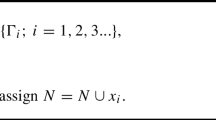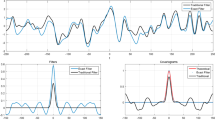Abstract
Moving average simulation can be summarized as a convolution between a spatial kernel and a white noise random field. The kernel can be calculated once the variogram model is known. An inverse approach to moving average simulation is proposed, where the kernel is determined based on the experimental variogram map in a non-parametric way, thus no explicit variogram modeling is required. The omission of structural modeling in the simulation work-flow may be particularly attractive if spatial inference is challenging and/or practitioners lack confidence in this task. A non-linear inverse problem is formulated in order to solve the problem of discrete kernel weight estimation. The objective function is the squared euclidean distance between experimental variogram values and the convolution of a stationary random field with Dirac covariance and the simulated kernel. The isotropic property of the kernel weights is imposed as a linear constraint in the problem, together with lower and upper bounds for the weight values. Implementation details and examples are presented to demonstrate the performance and potential extensions of this method.










Similar content being viewed by others
References
Alabert FG (1987) Stochastic imaging of spatial distributions using hard and soft information (Master thesis), Stanford University, Stanford
Barry RP, Ver Hoef JM (1996) Blackbox kriging: Spatial prediction without specifying variogram models. J Agric Biol Environ Stat 1(3):297–322
Bazaraa MS, Sherali HD, Shetty CM (1993) Nonlinear programming : theory and algorithms. Wiley, New York
Bochner S (1949) Fourier transform. Princeton University Press, London
Calder C, Cressie N (2007) Some topics in convolution-based spatial modeling. In: Proceedings of the 56th session of the International Statistical Institute, Lisbon
Calder CA (2008) A dynamic process convolution approach to modeling ambient particulate matter concentrations. Environmetrics 19(1):39–48
Chilès JP, Delfiner P (2012) Geostatistics: modeling spatial uncertainty. Wiley, New York
Cressie N (1985) Fitting variogram models by weighted least squares. J Int Assoc Math Geol 17(5):563–586
Desassis N, Renard D (2013) Automatic variogram modeling by iterative least squares: univariate and multivariate cases. Math Geosci 45(4):453–470
Deutsch CV (1992) Annealing techniques applied to reservoir modeling and the integration of geological and engineering (Well test) data. PhD thesis, Stanford University, Stanford
Deutsch CV (2002) Geostatistical reservoir modeling. Oxford University Press Inc, New York
Deutsch CV, Journel AG (1998) GSLIB: geostatistical software library and user’s guide. Oxford University Press, Oxford
Emery X (2010) Iterative algorithms for fitting a linear model of coregionalization. Comput Geosci 36(9):1150–1160
Emery X, Ortiz JM (2005) Estimation of mineral resources using grade domains: critical analysis and a suggested methodology. J S Afr Inst Min Metall 105(4):247–255
Fuentes M (2002) Interpolation of nonstationary air pollution processes: a spatial spectral approach. Stat Model 2(4):281–298
Fuentes M (2002) Spectral methods for nonstationary spatial processes. Biometrika 89(1):197–210
Geman S, Geman D (1984) Stochastic relaxation, gibbs distributions, and the bayesian restoration of images. IEEE Trans Pattern Anal Mach Intell 6(6):721–741
Gribov A, Krivoruchko K, Ver Hoef JM (2006) Modeling the semivariogram; new approach, methods comparison, and simulation study. In: Coburn TC, Yarus JM, Chambers RL (eds) Stochastic modeling and geostatistics; principles, methods and case studies. American Association of Petroleum Geologists, Tulsa, pp 45–57
Higdon D (1998) A process-convolution approach to modelling temperatures in the north atlantic ocean. Environ Ecol Stat 5(2):173–190
Higdon D (2002) Space and space-time modeling using process convolutions. In: Anderson C, Barnett V, Chatwin PC, El-Shaarawi AH (eds) Quantitative methods for current environmental issues. Springer, London, pp 37–56
Higdon D, Swall J, Kern J (1999) Non-stationary spatial modeling. In: Bernardo JM et al (eds) Bayesian Statistics 6. Oxford University Press, Oxford, pp 761–768
Isaaks EH (1990) The application of monte carlo methods to the analysis of spatially correlated data. PhD thesis, Stanford University, Stanford
Journel AG, Huijbregts CJ (1978) Mining geostatistics. Academic Press, London
Kirkpatrick S, Gelatt CD, Vecchi MP (1983) Optimization by simulated annealing. Science 220(4598):671–680
Majumdar A, Gelfand A (2007) Multivariate spatial process modeling using convolved covariance functions. Math Geol 79:225–245
Matérn B (1986) Spatial variation, 2nd edn. Springer, New York
Mosegaard K, Tarantola A (1995) Monte Carlo sampling of solutions to inverse problems. J Geophys Res 100(B7):12431–12447
Nocedal J, Wright SJ (2006) Numerical optimization. Springer, New York
NVIDIA Corporation (2010) NVIDIA CUDA C programming guide, version 3:2. NVIDIA Corporation, Santa Clara
Oliver DS (1995) Moving averages for gaussian simulation in two and three dimensions. Math Geol 27(8):939–960
OpenMP Architecture Review Board (2011) Openmp application program interface. Tech rep. URL:http://www.openmp.org/mp-documents/OpenMP3.1.pdf
Pardo-Igúzquiza E (1999) Varfit: a fortran-77 program for fitting variogram models by weighted least squares. Comput Geosci 25(3):251–261
Peredo O, Ortiz JM (2011) Parallel implementation of simulated annealing to reproduce multiple-point statistics. Comput Geosci 37(8):1110–1121
Rehman S (1995) Semiparametric modeling of cross-semiovariograms. PhD thesis, Georgia Institute of Technolog
Serrano L, Vargas R, Stambuk V, Aguilar C, Galeb M, Holmgren C, Contreras A, Godoy S, Vela I, Skewes M, Stern C (1996) The Late Miocene to Early Pliocene Ró Blanco—Los Bronces copper deposit, central Chilean Andes. In: Camus SR F, Petersen R (eds) Andean copper deposits: new discoveries, mineralizations, Styles and Metallogeny, Society of Economic Geologists, Special Publication no. 5, Littleton, Colorado, pp 119–130
Shapiro A, Botha JD (1991) Variogram fitting with a general class of conditionally nonnegative definite functions. Comput Stat Data Anal 11(1):87–96
Tarantola A (2004) Inverse problem theory and methods for model parameter estimation. Society for Industrial and Applied Mathematics, Philadelphia
Thièbaux HJ, Pedder MA (1987) Spatial objective analysis with applications in atmospheric science. Academic Press, London
Tikhonov AN, Arsenin VY (1977) Solutions of ill-posed problems. Scripta series in mathematics, Winston
Ver Hoef JM, Cressie N, Barry RP (2004) Flexible spatial models for kriging and cokriging using moving averages and the Fast Fourier Transform (FFT). J Comput Graph Stat 13(2):265–282
Wackernagel H (1994) Cokriging versus kriging in regionalized multivariate data analysis. Geoderma 62(1–3):83–92
Yao T, Journel AG (1998) Automatic modeling of (cross) covariance tables using fast fourier transform. Math Geol 30(6):589–615
Acknowledgments
The authors thankfully acknowledge the computer resources, technical expertise, and assistance provided by the Barcelona Supercomputing Center—Centro Nacional de Supercomputación (Spain) which supports the Marenostrum supercomputer, and the National Laboratory for High Performance Computing (Chile), which supports the Leftraru supercomputer. Additional thanks are owed to industrial supporters of ALGES laboratory, in particular Yamana Gold, as well as the Advanced Mining Technology Center (AMTC) and the whole ALGES team. The authors would also thank two anonymous reviewers for the suggested insightful ideas.
Author information
Authors and Affiliations
Corresponding author
Rights and permissions
About this article
Cite this article
Peredo, O., Ortiz, J.M. & Leuangthong, O. Inverse Modeling of Moving Average Isotropic Kernels for Non-parametric Three-Dimensional Gaussian Simulation. Math Geosci 48, 559–579 (2016). https://doi.org/10.1007/s11004-015-9606-x
Received:
Accepted:
Published:
Issue Date:
DOI: https://doi.org/10.1007/s11004-015-9606-x




